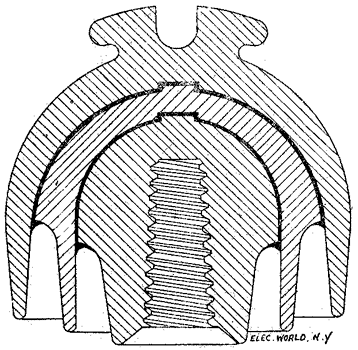[Trade Journal]
Publication: Electrical World
New York, NY, United States
vol. 31, no. 13, p. 394, col. 1
A Multiple Glazed Insulator.
It is well known that porcelain insulators of high insulation resistance depend quite largely on the glazed surfaces covering them for their ability to resist the puncture action of high pressure discharges, as well as on the highly vitrified and homogeneous mass of the body throughout.
The illustration herewith shows in cross section a design of insulator intended to increase the breakdown voltage by the use of several layers of glaze between the pin and the wire. The insulator shown is a triple petticoat style, the three petticoats being the rims of three separate pieces of clay. These are made to fit into each other nest-like, and are fitted with suitable centering projections and recesses to assure a co-axial mounting of the group. The separately moulded parts, after being pressed, are separately dried out by the usual process known as "biscuit firing." When ready to be put into the vitrifying kiln they are each dipped into and thereby coated with a glazing material, and then fitted into each other and placed upside down. More glazing material is then filled into the annular channels between the petticoats, after which they are vitrified as usual, the clay shrinking and the glazing material melting and filling the spaces left by the shrinkage. This renders the whole insulator a solid mass of highly resisting material, with internally protected layers of glaze that effectually bar out any leakage discharges that may occur, even if the outer glazed surface is chipped or broken by rough treatment or accident.
 |
| Multiple Glazed Insulator. |
A patent was issued on details of the construction of such insulators on March 8, 1898, to Mr. John W. Boch, general manager of the porcelain works of the R. Thomas & Sons Company, East Liverpool, Ohio.
